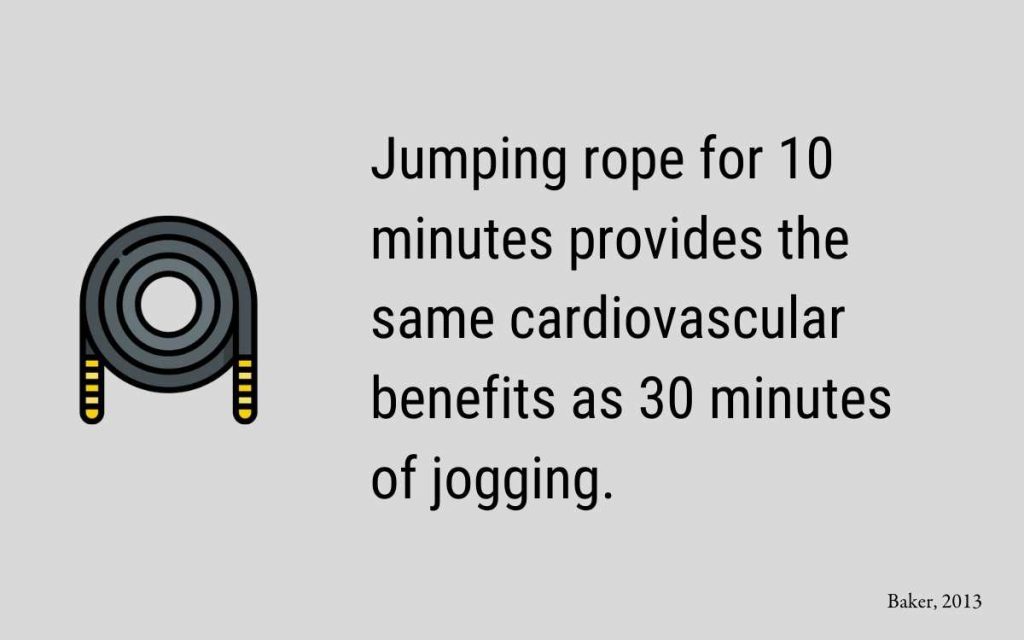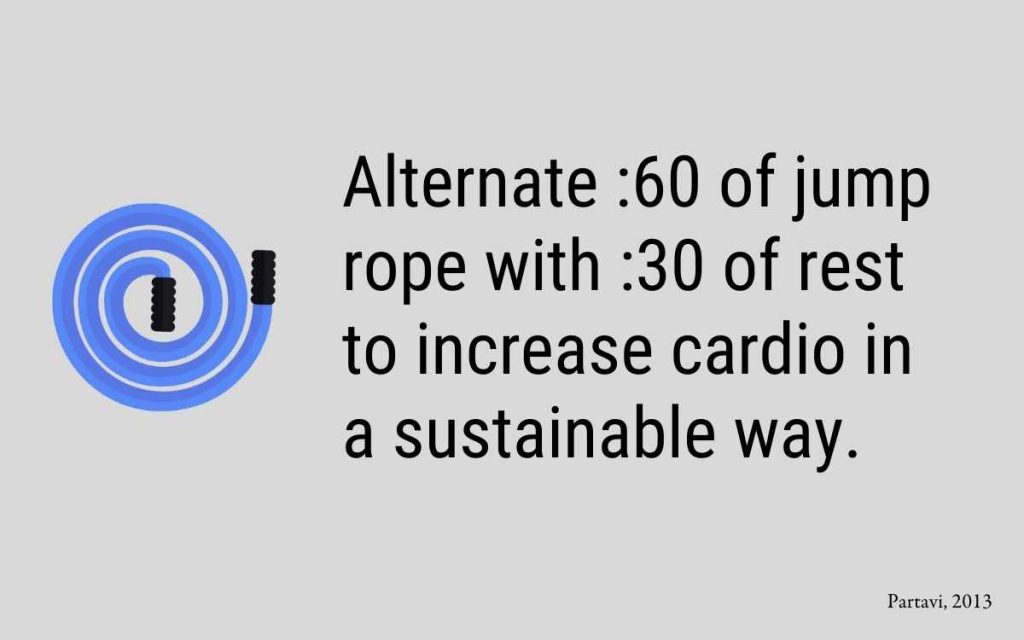Curious about what the optimal amount of time is to jump rope for improving cardio? Here’s a look at the best way to add jumping rope to your cardio arsenal.

Jumping rope is one of my favorite forms of cardiovascular activity.
The benefits of jumping rope are long and certified awesome:
- Develop explosive speed and power (comparable to traditional plyometric training)
- Proven to increase motor skills and coordination
- Improves bone density
- Promotes better posture
- Low impact
And on and on.
But when it comes to developing cardio, the jump rope punches way up.
Below is a deep dive on how long you should jump rope for cardio and some proven work-to-rest ratios that you can use to start improving cardio today, no matter your current fitness levels.
Here’s a look at how long you should jump rope to improve aerobic and cardiovascular capacity.
How much jump rope do you have to do to improve cardio?
Can you significantly improve your cardio in just ten minutes per day?
According to a study done with over 90 college-aged males, the answer is a resounding yes.
The group of young men was separated into two groups. Over six weeks, one group did ten minutes of jump rope daily, while the remaining participants jogged 30 minutes daily.
At the end of the experiment, everyone did the Harvard step test.
The jump rope group—again, just doing 10 minutes of rope skipping each day—significantly improved cardiovascular efficiency and performed just as well as the jogging group.1
In other words, the cardiovascular benefit of doing 10 minutes jump rope daily matches jogging for 30 minutes.

Another study, this time with younger (middle school-aged) children, had them do a 7-week jump rope training intervention where they slowly progressed week over week.
Three times per week, they did a jump rope workout.
Week one they did 15 minutes of jump rope (10x :60 jump rope with :30 rest), building up to a 50min session on the final week with the same work-to-rest ratio.
Compared to the control group, cardiovascular endurance in the jump rope group improved by a whopping 10.33%.
This particular paper gives a winning formula for how to start jumping rope for cardio.

A simple 2:1 ratio of exercise to rest allows you the opportunity to max out the cardio gains while getting enough to rest to extend the workout.
After all, if you haven’t picked up a jump rope in a while, doing ten minutes straight of jump rope will set your calves on fire.
The work to rest ratio of :60 jump rope and :30 rest is a great way to start jumping rope in a sustainable manner.
Can jump rope improve athletic performance?
Although jumping rope is a simple-enough-looking activity—what could be simpler than hopping up and down over a rope—it’s a full-body exercise in every sense of the word.
Jump rope requires the upper and lower body to work in rhythm and coordination, tapping your agility, strength, and speed.
Even for more experienced athletes, adding jump rope to your warm-up or as part of your regular training can help improve performance.
For example:
A study with amateur endurance runners found that adding 10-20 minutes of jump rope per week improved time trial performance and jumping ability in just ten weeks2.
How long do you have to jump rope to lose weight?
Jumping rope, even if it’s just for a few minutes per day, will help you get closer to your weight loss goals.
The key thing to remember is that working out is just one variable. Losing weight is a multi-variable challenge.
If your nutrition isn’t on point, and let’s say you are crushing ten beers at happy hour and eating McSadness from dawn to dusk, jumping rope for 10 minutes a day is going to little for weight loss.
But if you are on track with your nutrition, drinking lots of water, and handling all of the other variables, than yes, jumping rope each day will help you shed the pounds while also increasing your cardiovascular capacity.
Ultimately, how many calories you burn while jumping rope comes down to a variety of factors.
ACE Fitness, one of the more popular personal training certification providers, has an online calculator that guesstimates how many calories you will burn doing specific physical activities.
In the case of jumping rope, a 220-pound person will burn 400 calories doing “slow” jump rope for 30-minutes.
That number jumps to 600 calories if you are doing “fast” jump rope.
When you consider the low impact nature of skipping rope, the proven cardiovascular benefits of the exercise, and of course, the belly fat burning potential, that almighty jump rope starts to look pretty good, doesn’t?
The Bottom Line
Improving cardio can feel like a bit of a mystery at times.
There are a lot of factors in play, including current levels of conditioning, how well you are breathing (yup, seriously), and most obviously, the type of activity you are doing.
Jump rope is one of the activities we learn at a young age that can pay dividends for just about anyone and at any age.
More Jump Rope Guides
? 5 Best Jump Ropes for Every Kind of Athlete (and Beginners, Too). Ready to up your cardio game with a jump rope? Here’s a breakdown of the best jump rope for every kind of athlete, including beginners.
? 4 Best Mats for Jumping Rope. Protect your jump rope, ease the impact on your ankles, and crank up your rope jumping with our favorite jump rope mats.